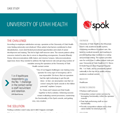Case studies
University of Utah Health
Overview
University of Utah Health is the Mountain West’s only academic health system, combining excellence in patient care, the latest in medical research, and teaching to provide leading-edge medicine in a caring and personal setting. The system provides care for more than 2 million patient visits per year. University of Utah Health is U.S. News & World Report’s Best Regional Hospital (No. 1 in Utah), and is consistently ranked No. 1 in quality in the nation among academic medical centers.
Industry
- Healthcare
Business drivers
- Reduce staff turnover
- Streamline contact center services by leveraging functionality within the operator console
- Train high-performing staff on new functionality
- Provide competitive salaries and a clear career ladder for internal growth
Solution
- Operator console
Results
- Decreased the employee turnover rate from 47% in 2016 to 20% in 2018
- Service improvements, including an abandonment rate decrease from 4% in 2016 to 2.7% in 2018
- Increased engaged employees from 33% in 2015 to 74% in 2017
- Increased the ROI of the department
The challenge
According to employee satisfaction surveys, operators at the University of Utah Health were feeling extremely overwhelmed. When asked what factors contributed to their dissatisfaction, most cited limited promotional opportunities and a lack of career development and training. This led to high staff turnover rates. The minute patient safety concerns started to arise due to errors in dispatching emergencies, Amanda (Mandy) Doxey, telecommunications skills trainer, and Jessica Campos, telecommunications supervisor, knew they needed to address the high turnover rate and growing number of mistakes among the operators at the University of Utah Health contact center.
“One of our biggest challenges was training every operator for every type of emergency call. It was impossible. We knew that our operators had the right technology to get the job done—in fact, our assumption was that we weren’t using the Spok console to the fullest potential,” explains Campos.
So, Doxey and Campos put their heads together to find a solution. Achieving success meant evaluating current processes, maximizing the functionality of the Spok console, and getting very, very creative.
The solution
Finding a solution wasn’t easy and it didn’t happen overnight.
“We had to make a case to separate the roles of dispatchers and operators, create a career ladder to grow our telecommunications abilities and prevent turnover, and relook at how we were using our technology,” said Doxey.
The pair first kicked off an evaluation process that included analyzing department metrics, identifying calls that require a high level of critical thinking, understanding how their current operators were using Spok console, and learning more about their operator and team concerns. From there, they had tangible information to present to senior leadership to gain buy-in and support from the team.
Next, they determined how to use their technology to the fullest and create more engaged staff. They identified ways to use Spok console more effectively—including expanding emergency services and specialty answering services, increasing help desk functionality, and streamlining call flows. For example, now when a call comes in, a pop-up screen is presented to the agent to help guide their process and provide support on the next steps to take.
They also underwent a reclassification of operator positions and rebranded the term “operator” to “communication service specialist” to better reflect the work of their team and instill a sense of pride in their work. At the same time, they worked with a compensation team to provide competitive salaries and a clear career ladder for internal growth.
“It was important to understand how we could use our Spok tools better to drive our innovation,” said Campos. “We’ve also used innovation from our team. They helped develop our department’s career ladder and are now implementing changes to better help our patients.”
Our department is no longer ‘just hospital operators.’ We’re now communication specialists who can confidently manage all the services we cover.
– Amanda Doxey, Telecommunications Skills Trainer
The result
By providing competitive salaries, a clear career progression, and more efficient ways to use Spok console, University of Utah Health increased engaged employees from 33% in 2015 to 74% in 2017. The turnover rate also went from 47% in 2016 to 20% in 2018. Moreover, the percentage of callers who hung up before speaking to a specialist compared to the number of incoming calls (abandonment rate) decreased from 4% in 2016 to 2.7% in 2018.
“Our department is no longer ‘just hospital operators,’” said Doxey. “We’re now communication specialists who can confidently manage all the services we cover.”



